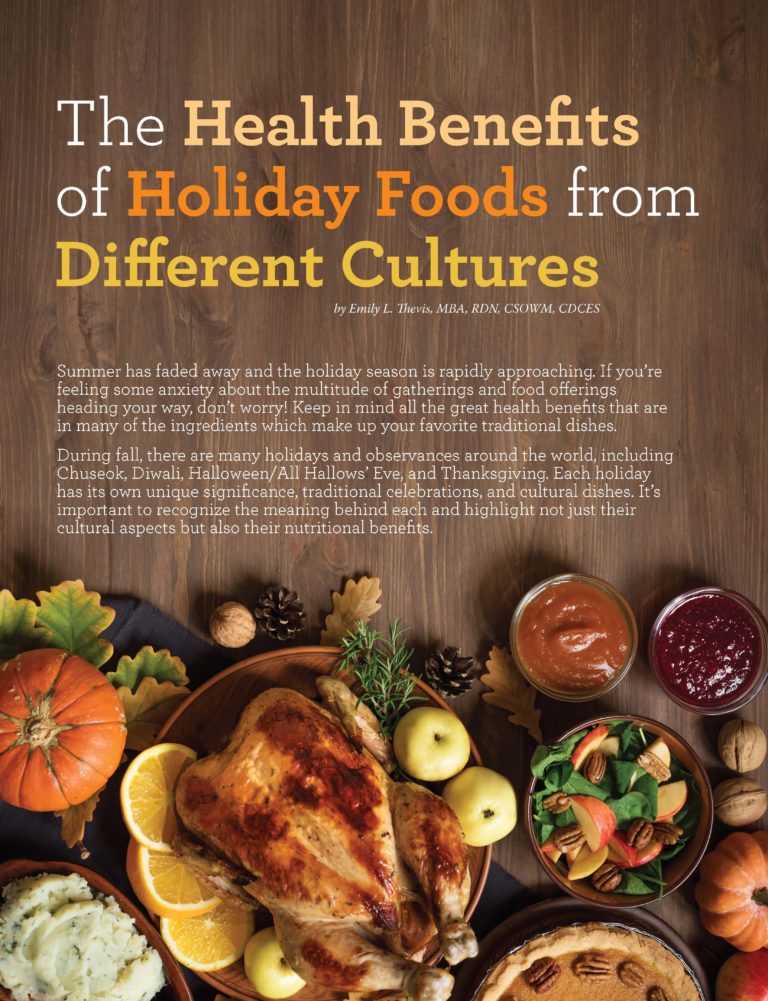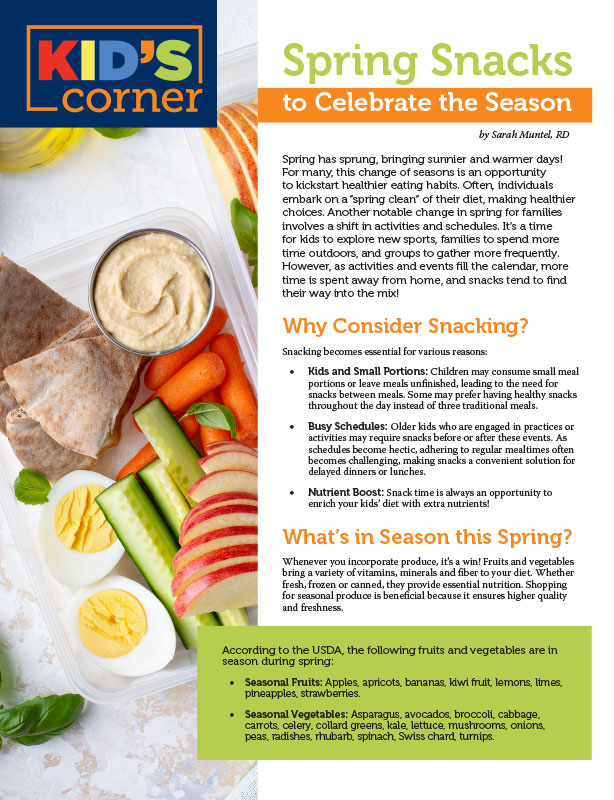The Health Benefits of Holiday Foods from Different Cultures


by Emily L. Thevis, MBA, RDN, CSOWM, CDCES
Fall 2022
Summer has faded away and the holiday season is rapidly approaching. If you’re feeling some anxiety about the multitude of gatherings and food offerings heading your way, don’t worry! Keep in mind all the great health benefits that are in many of the ingredients which make up your favorite traditional dishes.
During fall, there are many holidays and observances around the world, including Chuseok, Diwali, Halloween/All Hallows’ Eve, and Thanksgiving. Each holiday has its own unique significance, traditional celebrations, and cultural dishes. It’s important to recognize the meaning behind each and highlight not just their cultural aspects but also their nutritional benefits.
Chuseok
Chuseok is the Korean Thanksgiving and harvest celebration that takes place each fall. Families prepare a huge feast with the intent of nourishing everyone, so these dishes have a lot of health benefits to offer. Wanja jeon is a customary dish made with ground meat and/or tofu, eggs and vegetables prepared similarly to a meatball. Carrots, onions, and scallions lend this dish a ton of antioxidants.
Another common dish, Toranguk, is a soup made with taro and beef, which is a good source of protein and high in vitamins and minerals. The high fiber content of taro can help with digestion and regulation of blood sugars due to its filling nature. Taro is also rich in zinc, an essential mineral that is necessary for the immune system and wound healing.
Wanja-Jeon Recipe:
Ingredients:
- 1 lb. ground meat (beef or pork)
- 4-6 oz. tofu
- ½ onion
- ½ carrot
- 2 scallions
- 3 eggs, beaten
- 2 tsp. minced garlic
- 1 tbsp. sesame oil
- ½ cup flour
Directions:
- Chop all vegetables very finely.
- Squeeze all liquid from the tofu and crush it into small crumbles.
- In a large bowl, combine meat, tofu, vegetables and garlic. Mix well.
- Heat oil in a pan over medium-high heat.
- Create small balls with the meat and vegetable combination, then gently flatten.
- Drench each ball in flour and then the egg.
- Place balls into pan (in batches) and cook for about 2 minutes per side or until meat is cooked through.
Diwali
Diwali is the Hindu Festival of Lights, celebrating Lord Rama’s victorious return to his family. Common dishes prepared include:
- Samosas (made with peas, potatoes, and a combination of herbs and spices)
- Aloo Bonda (made with chickpea and rice flours, potatoes, masala, aloo, onions and ginger)
- Moong Dal Halwa (made with lentils and ghee)
The different spices used in these dishes are full of antioxidants. They include chili powder, cilantro, coriander seeds, cumin, ginger and masala. Like taro, coriander seeds are a good source of zinc, copper and iron, which help your red blood cells and improve heart health. Cumin has been used for centuries as an aid for various digestive and liver issues, as well as to prevent and treat different infections. Masala has anti-inflammatory properties and can benefit the skin as well as prevent bloating and other gastrointestinal ailments.
Halloween/All Hallows’ Eve
A version of Halloween/All Hallows’ Eve is recognized amongst many cultures and religions at the close of October. Ancient Romans celebrated this time as a harvest festival where fruits were given to their goddess, Pomona. Celtic culture tries to keep bad spirits away by wearing masks, while many Christians honor their Saints and the souls of loved ones who have passed on November 1st and 2nd.
Here in the U.S., we typically think of bobbing for apples, carving pumpkins, and consuming large amounts of candy, of course. Candy consumption may not provide the most health benefits, but apples and pumpkins are great holiday foods. Apples are high in fiber, vitamin C and potassium. The particular type of fiber found in apple peels, insoluble fiber, helps reduce constipation and can also help lower cholesterol. Vitamin C helps your body absorb iron and is an antioxidant, while potassium helps regulate blood pressure, muscle contraction, and fluid balance. There is a reason the saying “an apple a day keeps the doctor away” continues to live!
Pumpkin is also a good source of vitamins A and C, magnesium, and has high water content. Vitamin A is key in maintaining eye health and immune function, while magnesium plays a significant role in heart health and muscle function. Don’t throw those pumpkin seeds away, either! They are full of protein and heart-healthy fats.
Thanksgiving
Thanksgiving is a holiday well known to revolve around feasting and honoring the Native Americans who shared their resources and knowledge with the Pilgrims. Some of the most common dishes prepared include cranberry sauce, sweet potato casserole, and of course, turkey. Cranberries have long been thought to help prevent urinary tract infections and minimize symptoms while also potentially preventing ulcers and gum disease. Native Americans used these on wounds and as a preservative. The vitamin C in cranberries also helped prevent scurvy during these times, particularly for sailors.
Sweet potatoes are nutrient-packed and high in vitamins A, B-6, C and E. They also contain good amounts of calcium and potassium. Vitamin B-6 is important for brain and nervous system function and vitamin E protects cells from free radicals. Cinnamon is used in the preparation of sweet potato casserole and several other Thanksgiving dishes and has its own health advantages. It, too, reduces inflammation which is linked to several different chronic diseases, such as cardiovascular disease and type 2 diabetes. Studies have shown it can help lower total cholesterol (LDL – the “bad” cholesterol) and triglycerides.
Last but not least, the main character at Thanksgiving dinner is the turkey. Turkey is a low-fat protein option. It also contains selenium and many B vitamins, including B-6 and niacin, which are vital to turning your food into energy. Tryptophan is a source of niacin, and this amino acid is frequently blamed for the post-meal nap. While tryptophan is no higher in turkey than in most other meats, it is essential to the production of serotonin and melatonin in the body. Selenium may reduce the risk of cancer and help the production of DNA and healthy thyroid hormones.
Conclusion
All of these foods provide a huge variety of nutrients and can benefit your health throughout the fall season and year-round – and there’s so much we didn’t cover! Let go of the guilt that is so often associated with holidays. Celebrate health and happiness with your loved ones.
About the Author:
Emily L. Thevis, MBA, RDN, CSOWM, CDCES, received her Bachelor of Science in Nutritional Sciences from Louisiana State University in 2011, and recently graduated in December 2021 with her Master’s in Business Administration with a concentration in Healthcare Administration Systems. She is a Certified Specialist in Obesity and Weight Management, as well as a Certified Diabetes Care & Education Specialist. Her professional passion lies in bariatric surgery, though she has transitioned into being a physician liaison with the General Surgery, Heart & Vascular, Oncology, and GI service lines for Memorial Hermann in Houston, Texas.
by Sarah Muntel, RD Spring 2024 Spring has sprung, bringing sunnier and warmer days! For many, this…
Read Articleby Robyn Pashby, PhD Winter 2024 “No one is ever going to date you if you don’t…
Read Articleby Michelle “Shelly” Vicari Winter 2024 Winter has arrived! Don’t allow the chilly and damp weather to…
Read Article








